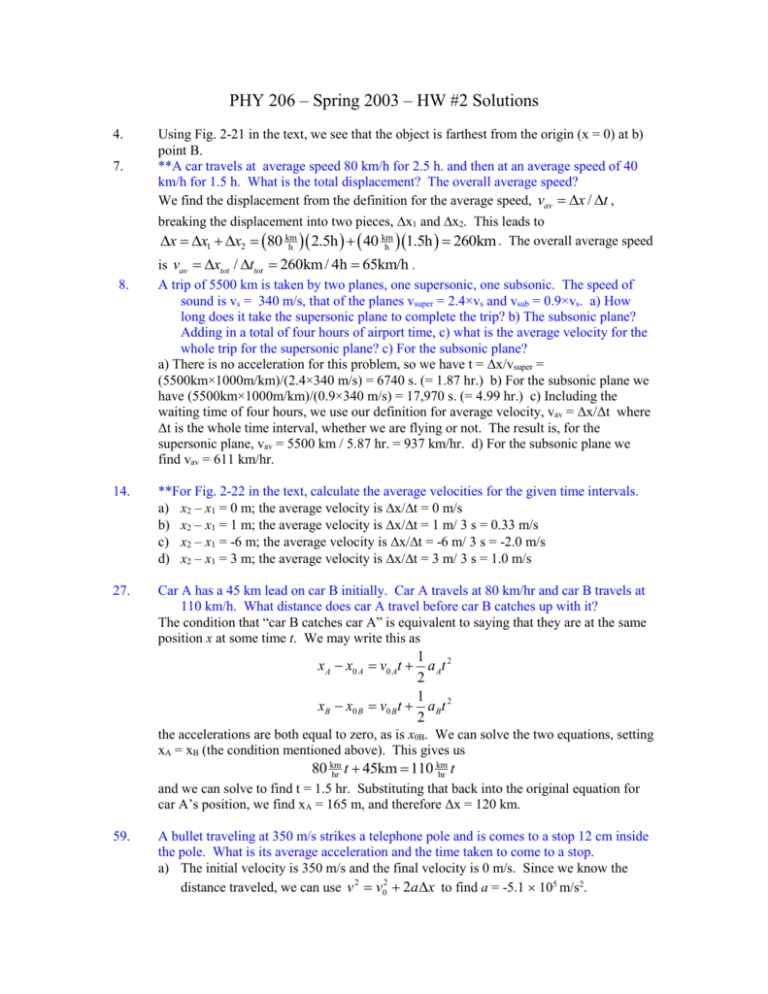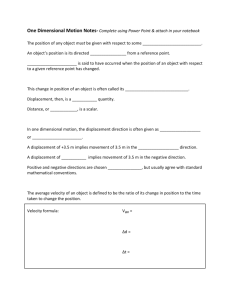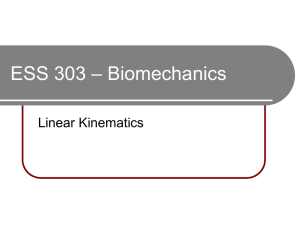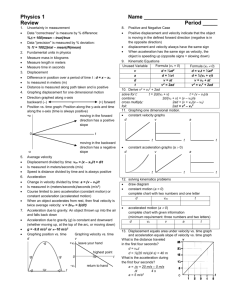Solutions for HW #2
advertisement

PHY 206 – Spring 2003 – HW #2 Solutions 4. 7. Using Fig. 2-21 in the text, we see that the object is farthest from the origin (x = 0) at b) point B. **A car travels at average speed 80 km/h for 2.5 h. and then at an average speed of 40 km/h for 1.5 h. What is the total displacement? The overall average speed? We find the displacement from the definition for the average speed, vav x / t , breaking the displacement into two pieces, x1 and x2. This leads to km . The overall average speed x x1 x2 80 km h 2.5h 40 h 1.5h 260km 8. is vav xtot / ttot 260km / 4h 65km/h . A trip of 5500 km is taken by two planes, one supersonic, one subsonic. The speed of sound is vs = 340 m/s, that of the planes vsuper = 2.4×vs and vsub = 0.9×vs. a) How long does it take the supersonic plane to complete the trip? b) The subsonic plane? Adding in a total of four hours of airport time, c) what is the average velocity for the whole trip for the supersonic plane? c) For the subsonic plane? a) There is no acceleration for this problem, so we have t = Δx/vsuper = (5500km×1000m/km)/(2.4×340 m/s) = 6740 s. (= 1.87 hr.) b) For the subsonic plane we have (5500km×1000m/km)/(0.9×340 m/s) = 17,970 s. (= 4.99 hr.) c) Including the waiting time of four hours, we use our definition for average velocity, vav = Δx/Δt where Δt is the whole time interval, whether we are flying or not. The result is, for the supersonic plane, vav = 5500 km / 5.87 hr. = 937 km/hr. d) For the subsonic plane we find vav = 611 km/hr. 14. **For Fig. 2-22 in the text, calculate the average velocities for the given time intervals. a) x2 – x1 = 0 m; the average velocity is x/t = 0 m/s b) x2 – x1 = 1 m; the average velocity is x/t = 1 m/ 3 s = 0.33 m/s c) x2 – x1 = -6 m; the average velocity is x/t = -6 m/ 3 s = -2.0 m/s d) x2 – x1 = 3 m; the average velocity is x/t = 3 m/ 3 s = 1.0 m/s 27. Car A has a 45 km lead on car B initially. Car A travels at 80 km/hr and car B travels at 110 km/h. What distance does car A travel before car B catches up with it? The condition that “car B catches car A” is equivalent to saying that they are at the same position x at some time t. We may write this as 1 x A x0 A v0 At a At 2 2 1 xB x0 B v0 B t aB t 2 2 the accelerations are both equal to zero, as is x0B. We can solve the two equations, setting xA = xB (the condition mentioned above). This gives us km 80 km hr t 45km 110 hr t and we can solve to find t = 1.5 hr. Substituting that back into the original equation for car A’s position, we find xA = 165 m, and therefore Δx = 120 km. 59. A bullet traveling at 350 m/s strikes a telephone pole and is comes to a stop 12 cm inside the pole. What is its average acceleration and the time taken to come to a stop. a) The initial velocity is 350 m/s and the final velocity is 0 m/s. Since we know the distance traveled, we can use v 2 v02 2a x to find a = -5.1 105 m/s2. 60. 71. b) To find the time we use v v0 at to find t = 686s. **A plane landing on an aircraft carrier has only 70 m to stop. The initial speed is 60 m/s. What is the acceleration and how long does it take to stop? We can find the acceleration from v 2 v02 2a x , with v = 0 m/s and v0 = 60 m/s. This leads to an acceleration a = -25.7 m/s2. Note the “-“ sign. To find the time we can use v v0 at which leads to t = 2.33 s. **A bus accelerates at 1.5 m/s2 for 12 s. and then travels at constant speed for 25 s. and finally slows down at a rate of -1.5 m/s2. What is the total displacement and what is the average velocity? We have to break this problem into three parts; by looking at the symmetry of the motion, we see that the time needed to decelerate is equal to the acceleration time, 12 s. The displacement during the first (and third) intervals is given by x1 1 2 at 108m , since 2 the initial speed is zero in the first interval. The speed at the end of the first interval is v at 18 ms . During the constant speed motion the displacement is x2 vt 450m . Therefore the total displacement is x = 666 m. The average speed is vav x / t 666m / 49s 13.6 ms . 77. A rock dropped from a cliff falls one-third of its total distance to the groundin thelast second of its fall. How high is the cliff? For this problem we will have to work in two parts. First we can take the total fall and use x0 = h, v0 = 0, a = -9.8 m/s2. Thus, x 0 h 1 2 2h at t . For 2 9.8 sm2 the first part of the flight, up until the last second, the final height is h/3, the time is t – 1s. We can write another equation for the position, h 1 h 0 9.8 sm2 3 2 2h . 1 9.8 m2 s We solve this for h, using the quadratic equation and arrive at h = 145 m. 81. **A motorcycle policeman catches a speeder after 1400 m. He has a 2 s. delay before starting, accelerates from rest to 110 km/h (30.6 m/s) at a = 6.2 m/s2 and then travels at constant speed. How fast was the car moving? We will solve this by finding the total time of travel for the motorcycle, then solve for the speed of the car using v 1400m / ttot , since both vehicles have a common time of travel. There are three time intervals: i) t1 = 2 s. at rest, ii) t2 accelerating, and iii) t3 at constant speed. The time spent accelerating is t2 v / a displacement during that time is x2 30.6 ms 4.9s . The 6.2 sm2 v 2 v02 75m (v0 = 0 m/s here). Since we know 2a the total displacement to be 1400 m, during the constant speed segment the motorcycle travels x3 = 1400 – 75 m = 1325 m. The time for that distance to be covered is t3 1325m / 30.6 ms 43.3s . The total time is thus ttot = 2s.+4.9s.+43.3s. = 50.2 s., and the speed of the car was the total distance divided by the total time, vcar = 1400m/50.2 s = 27.9 m/s (=100.4 km/h). 101. On a graph showing position vs. time, a parabola opening upward represents (a) positive acceleration. 114. **To cover 50 m in 21.81 s., Tom Jager had to accelerate for 2 s. at a constant rate, and then swim the rest of the time at constant speed. What was the acceleration? We break the problem into two parts. Starting from rest, we have v0 = 0, x0 = 0, t1 = 2 s. 1 2 a 2s. . During the second stretch, of t = 21.81s. – 2 s., we 2 have x2 v 19.81s. v0 at1 19.81s. 2 19.81 a . The two Δx terms have to In that first stretch, x1 add to 50 m., so we have 50m= 118. 1 a 4s 2 a 39.62s 2 a 1.20 sm2 . 2 **A train accelerates at 1 m/s2 for 450 m, then decelerates at the same rate for the same distance. Sketch v vs. t and x vs. t over the full journey. We can calculate the time taken to travel to the halfway point, t 2x 30s. At that a point the speed is v = 30 m/s. The plots of position and velocity as a function of time are shown below. Subway Train 35 1000 900 800 25 700 20 600 500 15 400 300 10 5 Velocity 200 Position 100 0 Position (m) Velocity (m/s) 30 0 0 10 20 30 40 50 60 Tim e (s) 124. The speed of a base runner is 9.5 m/s, the distance between bases is 26 m and the pitcher is 18.5 m from the plate. The runner leads off by 2 m; will he successfully steal second base or not? Here we have to assume a lot. Take the pitch to travel at 35 m/s, and assume that the catcher can throw at 27 m/s. The time for the ball to travel the distance from the mound to the plate is t1 26m 0.74s. The catcher’s throw takes a time 35 ms t2 262 262 m 1.36s . If we assume the catcher needs 0.5 s to get the ball out of 27 ms his mitt and release the ball again, we have a total time of 2.60 s. The runner takes a time tr 26m 2m 2.52 s. According to this calculation, it will be very close, but 9.5 ms the runner will successfully steal the base.








